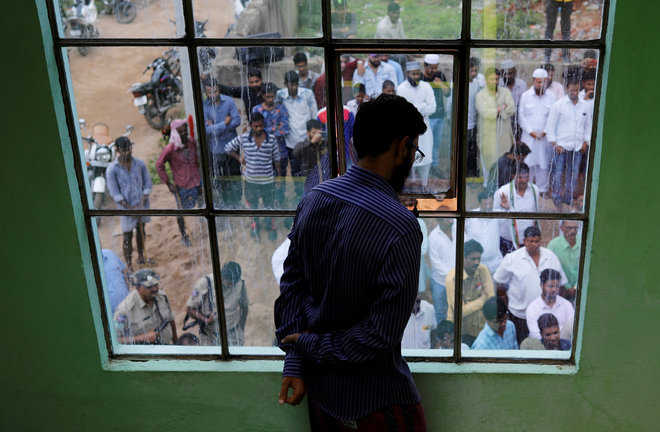Murk/Mumbai, July 29
In the tiny hamlet of Murki, Inspector VB Yadwad surveyed a pile of bricks and stones in a ditch where he and his colleagues were attacked earlier this month while trying to save five men from a violent mob.
“We tried hard to stop them,” said Yadwad, pointing to injuries on his back. “They wouldn't listen to anyone.” Yadwad was one of eight policemen who rushed to the village on July 13 to try to control a mob that attacked the five friends, wrongly assuming they were child kidnappers.
The vicious assault left one of them, Mohammed Azam, a UK-educated IT worker from Hyderabad, dead. All eight officers were injured, two seriously. Azam, who was 32 and worked for global consulting services firm Accenture, is one of the latest victims of a wave of lynchings in India, triggered by false messages about child kidnappings spread via platforms like Facebook's WhatsApp.
The Indian Government says it is not tracking data for lynchings, but data portal IndiaSpend has tallied more than 30 deaths from nearly 70 such incidents since January 2017.
The police probing the lynchings say these are often triggered by deep-rooted prejudices against minorities. Azam's own job at Accenture, according to his younger brother Akram, included reviewing the propriety of video content before it was uploaded to Alphabet Inc's YouTube. “India is vulnerable due to religious and caste fault lines," said Rema Rajeshwari, SP, Telangana, where lynchings have taken place recently. “When you add WhatsApp to the mix, things can go out of control.”
In Murki, messages circulating on a local WhatsApp group, late in the day Azam was killed, simply said: "Child kidnappers found in Murki." Videos and photos of Azam and his four friends, taken just before, were attached. The five, who were in a new cherry red SUV, had set out from Hyderabad that day for a drive into the countryside. While passing through a hamlet where they planned to picnic, they tossed chocolates towards a group of children, according to three of the survivors.
What the men thought was a kind gesture in a poor village cost Azam his life, as a mob of angry villagers savagely attacked him and his friends. The assault began when the group stopped to take selfies amid lush green fields beside a pond, just after driving by the kids, according to interviews with the survivors, police, villagers and other eyewitnesses.
Three villagers first walked up and started deflating their tyres. "We asked them why are you dong so? They yelled: you men are child kidnappers," said retail worker Mohammed Afroz, one of the survivors. While the five tried to plead their innocence, dozens of villagers gathered. Some carried pick-axes and sticks. Photos and videos of the five men were posted on a 180-member WhatsApp group named 'Mother Murki', according to the police.
Salham Al Kubassi, a Qatari national, who was friends with Azam, was among the first to be hit. While two of the friends tried to reason with the mob, Kubassi, a policeman in Qatar, jumped into the SUV with Azam and their friend Mohammed Salman, and sped away, according to the police. But a makeshift roadblock was set up at a nearby junction.
The SUV careened off the road after it hit a tree trunk the villagers had placed on the road and ended in a small, dry riverbed, the police said. It was the attack here that claimed Azam's life.
Villagers, men and women, threw bricks and rocks at the toppled SUV. Some tied ropes around Azam and Salman and dragged them out of the vehicle as a crowd of 200 gathered, hurling abuses.
Azam's killing has sent a chill through Murki, where many fear discussing the attack following the arrest of more than 30 men and women from the area. No one has yet been charged. Asked why they attacked the men, Vijay Biradar, a village elder, said “People made a mistake. Did you see the Qatari's face? His beard? He looked like a terrorist.” While the police say no child kidnappings were recorded in or around Murki, child trafficking is a problem in India, and many children are sold into slavery, especially forced labour.
About 250,000 children were registered as missing on government’s Track Child portal between January 2012 and March 2017.
Photos and videos of the bodies of children being mutilated by alleged child abductors have been circulated via WhatsApp in several parts of India. “The people may not be able to read or write, but everyone understands photos and videos," says SP Rajeshwari.
In many lynchings, police say minority groups such as those from lower castes, have been targets. Hindu vigilantes have also killed over 24 Muslims for transporting cows in the past year, accusing them of slaughtering the animal considered sacred in Hinduism. — Reuters
Unlock Exclusive Insights with The Tribune Premium
Take your experience further with Premium access.
Thought-provoking Opinions, Expert Analysis, In-depth Insights and other Member Only Benefits
Already a Member? Sign In Now










